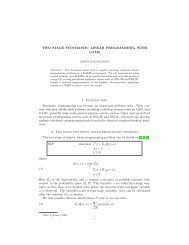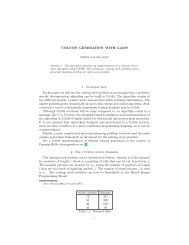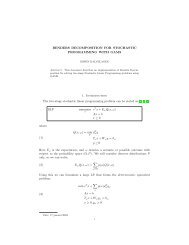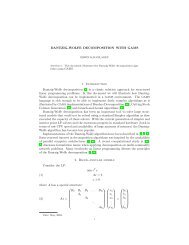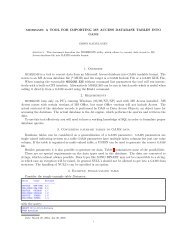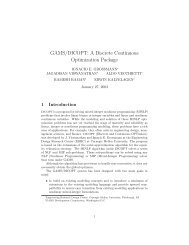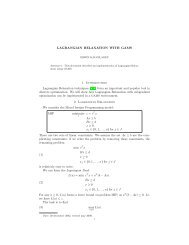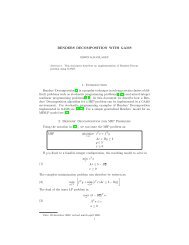Langford's Problem - Amsterdam Optimization Modeling Group
Langford's Problem - Amsterdam Optimization Modeling Group
Langford's Problem - Amsterdam Optimization Modeling Group
Create successful ePaper yourself
Turn your PDF publications into a flip-book with our unique Google optimized e-Paper software.
4 ERWIN KALVELAGEN<br />
be unique, is two dimensional. We can add the constraint ∑ x i = 1 + 2 + · · · +<br />
27. This constraint is automatically valid for an integer solution, but it helps the<br />
optimization algorithm when there are still fractional solutions. We have added<br />
priorities that tell the solver to place first the high numbered triples, as they are<br />
widely spaced, and are difficult to “squeeze in.” Priorities are especially important<br />
when the solver does not receive any good pricing signals, as this model does not<br />
have a proper objective function that can help to distinguish solutions. When<br />
solving this model with Cplex we can add the option mipemphasis 1 (emphasis<br />
on finding a feasible integer solution) as the first integer solution is immediately<br />
(proven) optimal, given the dummy objective function. Note that this also implies<br />
that we don’t have to set an OPTCR value. A simple way to check the solution given<br />
in equation (1) is also provided. It is commented out, but a few simple edits will<br />
enable it.<br />
The solution found with Cplex is as follows:<br />
---- 132 VARIABLE x.L locations (1..27)<br />
m1 m2 m3<br />
n1 23 25 27<br />
n2 18 21 24<br />
n3 3 7 11<br />
n4 10 15 20<br />
n5 2 8 14<br />
n6 5 12 19<br />
n7 1 9 17<br />
n8 4 13 22<br />
n9 6 16 26<br />
This is different than the solution mentioned in equation (1). Indeed, there are<br />
three different solutions for L(3, 9).<br />
3. A second model<br />
This is not the only possible formulation (which is a familiar theme). For instance<br />
we can calculate for all combinations (i, j), (i ′ , j ′ ):<br />
(2) d(i, j, i ′ , j ′ ) = x(i, j) − x(i ′ , j ′ )<br />
and then require that |d(i, j, i ′ , j ′ )| ≥ 1 for all (i, j) ≠ (i ′ , j ′ ). The minimum distance<br />
requirement can be linearized by saying d(i, j, i ′ , j ′ ) ≤ −1 ∨ d(i, j, i ′ , j ′ ) ≥ 1. This<br />
“or”-constraint can be modeled easily using binary variables δ i,j,i′ ,j ′:<br />
(3)<br />
d(i, j, i ′ , j ′ ) ≥ 1 − δ i,j,i′ ,j ′M<br />
d(i, j, i ′ , j ′ ) ≤ −1 + (1 − δ i,j,i′ ,j ′)M<br />
We need to choose an appropriate value for M. The following model implements<br />
this.<br />
3.0.2. Model langford2.gms. 2<br />
$ontext<br />
Langford’s <strong>Problem</strong> L(3,9),<br />
alternative formulation<br />
Erwin Kalvelagen, July 2002<br />
References:<br />
2 http://amsterdaomoptimization.com/models/langford2.gms



